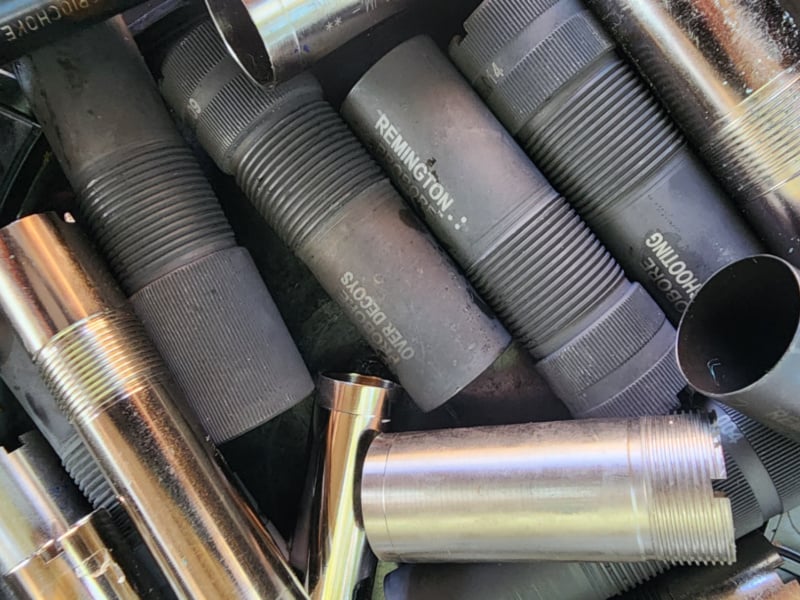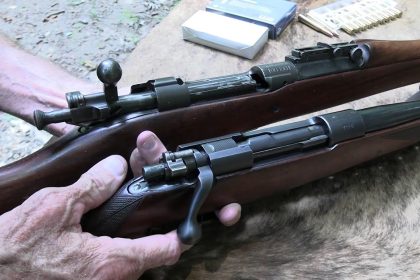It doesn’t really matter if you’re running a shotgun for home defense or hunting quail: shotgun chokes matter. There’s a reason most shotguns ship from the manufacturer with some assortment of chokes included and why there’s a burgeoning market of high-end options. You might not care about shotgun chokes, but they care about you. Your shotgunning success is going to be far better if you pay attention to the choke you’re using. Check out these common chokes, what they do, and why you might want them (or not).
What’s a shotgun choke tube?
The choke tube on a shotgun is a cylindrical piece of metal that screws into the muzzle end of the barrel. The exact length of the choke depends on the model. Its purpose is to affect the spread of the pellets. Basically, chokes that are wider open allow a broader pattern on target faster. However, that doesn’t automatically mean open is better or worse. Many factors come into play, such as distance and application.
What do shotgun choke measurements mean?
At its simplest, the choke measurement isn’t about the size of the actual bore of the barrel. Instead, shotgun choke measurements list the difference their use will make in inches. For example, a 12-gauge shotgun has a .730-inch bore. An Improved Cylinder choke will be marked with a 0.010, meaning it will restrict the bore of the 12 gauge by 0.010 inches. That turns your 0.730-inch bore into a 0.720-inch bore. It might not sound like much, but those changes in bore size can make a significant difference in how quickly your pellets spread and what the resulting pattern looks like.
What sizes of shotgun chokes are there?
The most common chokes are Full (0.30 inches), Improved Modified (0.025 inches), Modified (0.020 inches), Light Modified (0.015 inches), and Improved Cylinder (0.010 inches). Some of the other types include Skeet (0.005 inches) and XX-Full, the latter of which comes in numerous sizes.
The Mossberg X-Factor Ported Turkey Choke, which is an XX-Full, restricts the bore all the way down to 0.670 inches (meaning the choke itself is a 0.060 inch). XX-Full chokes generally restrict between 0.040 inches and 0.090 inches. Be aware that some manufacturers will label a choke tube using common names, but the exact size will be different than what is considered the classic sizing or standard sizing method. Never assume you know the size of a choke based on its name. Instead, read the specifications and find out for sure.
What do different-sized shotgun chokes do?
Full chokes are commonly used by shotgunners looking for a wider pattern at a greater distance. A Full choke is a more restrictive choke size, meaning the payload will spread at a slower rate. XX-Full chokes are extremely restrictive, which is fantastic for shots taken at longer distances like you do while turkey hunting.
In contrast, an Improved Cylinder choke isn’t that restrictive and allows the pellets to spread out at a faster rate, enabling a greater number of pellets to hit a broader area at closer distances. That’s particularly useful for dove hunting—they’re tiny, fast targets typically hunted at relatively close range—and upland bird hunting.
Of course, there are many other choke sizes to consider. Here’s a basic rundown of the common sizes. It’s not a complete list; it’s just generalities to give you an idea of how they work.
- Improved Cylinder (IC)
- Hunting dove, upland birds, rabbits, and deer (with slugs). Sometimes used by waterfowl hunters in flooded timber. The ideal effective range is between 20 and 30 yards.
- Light Modified (LM)
- Sporting clays, dove, and waterfowl hunting. Often late-season goose. The ideal effective range is between 20 and 35 yards.
- Modified (M)
- Trapshooting, goose hunting, and other bird hunting where longer shots may be required. The ideal effective range is between 25 and 45 yards.
- Improved Modified (IM)
- Trapshooting, waterfowl over rice fields or open water, squirrels, and turkeys. The ideal effective range is between 25 and 50 yards.
- Full (F)
- Waterfowl, turkey, crows, rabbits, and deer (with buckshot). The ideal effective range is between 40 and 50 yards.
- XX-Full
- Turkey, although it can be used for any target at significant distances. The ideal effective range is 40 yards and beyond, with the outer yardage depending on the specific choke size.
Something to remember is that the specific load you’re using matters, too. Steel shot will give you greater distance than lead. In fact, if you’re using lead shots, you might lose up to 10 yards of effective range (all numbers listed above are for steel shots). Also, certain loads will allow you greater distances beyond the listed ranges. Pellets, buckshot, and slugs all offer different results.
What choke for self-defense?
If your shotgun is specifically designed for self-defense use, it will have a cylinder or open choke. That means there’s no restriction to the bore size, and the pattern will open up faster than it would if the bore were restricted. Some defensive-use shotguns are manufactured with the bore threaded for choke tubes. If yours is, you might be wondering if it could benefit you to put a different choke in it.
The answer is that it depends on the distance of your most likely shots to be taken with that shotgun and what ammo you’ll be using. Incidentally, that’s true for all choke tubes. But back to home defense.
If you’re going to run a shotgun or home defense—or self-defense in your truck—you’ll usually be fine without changing the choke if it’s made for that purpose. Further, it’s important that you pattern your shotgun. Many gun owners don’t understand how the payload from a shotgun patterns on target, meaning they fail to realize their shotgun isn’t likely to have time to spread out in a defensive situation. That is also why shotguns designed for defensive use have a cylinder or open chokes, which allows for a faster spread. Shotguns can be great tools for self-defense as long as you understand and work within their limitations.
How do you choose a choke tube?
Your choice of choke tube involves figuring out what your target is, the distance at which you expect to shoot it, and what ammunition you’re using. Ammunition comes into play more after you’ve figured out targets and distance. There’s also an exception where certain chokes—often Full—can’t be used with steel shot. That detail should be noted by the manufacturer. Not all choke tubes can be used with all types of ammo or for all applications, although some are more versatile than others.
If you’re a hunter—and you probably are if you’re reading this—you’d benefit from having more than one option for chokes. Odds are you’ll be hunting different birds at varying distances, and that means changing choke tubes.
Once you’ve chosen your choke tube and ammo, you need to take the time to pattern it. Understanding the spread at various distances is important, and it varies depending on factors like barrel length, choke size, and ammunition. Change any one of those details, and your results can change, too. It’s never a waste of ammunition to familiarize yourself with the ammo’s performance on target.
How do you install a shotgun choke?
Shotguns that ship with a threaded bore typically also ship with a small choke tool that can be used to remove and install choke tubes. It’s also usually possible to do it by hand with no tools, but having the right tool can help with stubborn chokes and also make it easier to tighten it as needed. There are also tools available for different brands of chokes. The good news is that it only takes a matter of moments to swap out chokes, and you don’t need a gunsmith.
Do shotgun chokes really matter?
Yes, the choke tube on your shotgun matters. It affects how the shotgun patterns are shot and at what range they are most effective. When you’re new to shotguns, you might ignore the chokes in favor of getting used to the platform, but before long, you need to learn about choke tubes. Experience is a great teacher, but so is doing your research in advance.
Read the full article here










